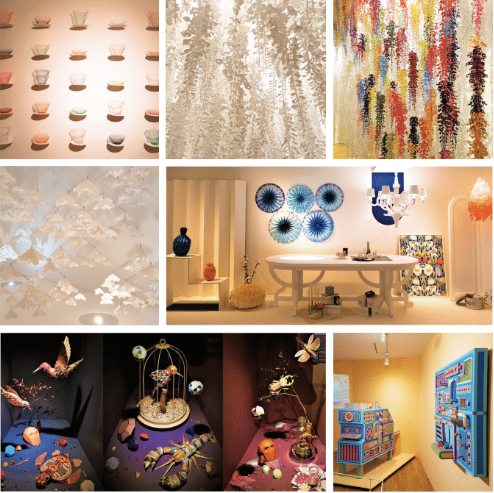Sitting in the middle of a classroom full of students, you look around. The friend next to you is taking notes, another student is doodling on her notebook, and the one behind you is sneakily reading a book instead of paying attention to the lecture. You stop to wonder how many days are left until summer break and turn your head to look at the calendar hanging on the wall. Suddenly, you realize, ‘Wow, paper has so many various uses.’ Paper can show and express knowledge, thoughts, emotions, and feelings. With that in mind, this SMT reporter visited Daelim Museum to admire paper presented in unconventional forms.

Paper Like Never Before
Paper is a thin flexible material used for many purposes including writing, drawing, printing, wrapping, cleaning, and folding. It is believed to have been first invented in China around the second century BC. From China it spread to the Middle East and then to Europe in the thirteenth century. Since its invention in the second century BC, paper has been utilized worldwide in infinite ways and forms. However, more recently, paper has developed beyond its typical usage. It is being used in works of art as a material that artists can use freely to fully express themselves. ‘Paper, Present’ is an exhibition of artwork by various artists that enables gallery goers to become a part of the art. There are perfect photo spots along with delicately displayed pieces of art. The exhibition excellently portrays paper, from simple white to bright colors, transformed into some of the most exquisite and beautiful pieces of artwork. There are several ways to reach Daelim Museum from Sookmyung Women’s University. The quickest ways are by riding either Bus 1711 or 7016 from Sookmyung Women’s University bus stop and getting off at Gyeongbokgung Palace bus stop. Once there, use any map application to locate the museum and follow the route as outlined on the app. It should not take more than ten minutes to arrive on foot.
Unfolding the Present

'Paper, Present' contains paper art expressing components of nature and emotion such as wind, stars, light, sunshine, memories, and fluttering joy. The exhibition is composed of seven different sections decorated by various artists. The first section greets visitors with eight small paper sculptures, four on each side of the room, that seem to twinkle in the dark space like stars in the night sky. In front of the back wall is a large-scale installation that resembles fierce swaying waves. Only folded paper was used to create such wonder. Past the stars and waves is a smaller section with two large structures. Carefully cut out geometric and organic patterns on white sheets of paper, take advantage of light passing through the holes to manipulate casted shadows. The third section is likely where most people will spend much of their time because of the wonderful photo spots. Using traditional paper from Gifu Prefecture in Japan, a pure white space resembling the beauty of Gifu is presented. White mobile like sculptures hanging from the ceiling cast light shadows on the floor. Visitors will surely admire the pure and astonishing view and spend a lot of time trying to take perfect pictures. Going up the stairs, visitors are taken to the next section, which shows paper in daily life. TORAFU ARCHITECTS, Jule Waibel, Studio Job, and Tord Boontje worked together to create "hidden wonders behind the ordinary". Common furniture such as everyday lamps, mirrors, cabinets, curtains, tables, chandeliers, flower vases, and wall decorations that normally appear dull and boring are transformed into delicate pieces of artwork, constructed solely from paper. The next two sections make visitors feel as though they are walking inside a fairytale. Team Zim & Zou and designer Wanda Barcelona, renowned for collaborations with famous brands like Hermès, Microsoft, Time, Washington Post, Dior, Colette, and more, designed a window display and showroom fi lled with vivid colors intermixed with pure white. Zim & Zou’s toy-like sculptures and animal pieces, and the room that contains four thousand paper flowers and another four thousand Swarovski crystals by Wanda Barcelona was especially impressive. The exhibition is wrapped up with a path of pink paper reeds in the final section, which is Created by Maum Studio, a design group in Korea. The warm lighting and mood of this section gives it a romantic atmosphere.

Grab a Sheet of Paper
At the entrance of the museum is the Museum Shop, where visitors are greeted by colorful souvenirs. Visitors may browse the Museum Shop before and after looking around the exhibition. The shop sells delicate items all made of paper such as mobiles, bookmark pens, masking tape, pop-up cards, postcards, and Do-It-Yourself (DIY) kits. A bonus to visiting the exhibition is that if you show your exhibition admissions ticket or a picture of yourself taken at the exhibition, you may revisit anytime throughout the exhibition period, free of charge. This SMT reporter is also seriously considering revisiting to learn more about each display by borrowing an audio guide.

| Place | 21, Jihamun-ro 4-gil, Jongno-gu, Seoul, Republic of Korea |
| Exhibition Period | December 7, 2017 – May 27, 2018 |
| When | TUE, WED, FRI, and SUN 10:00 a.m. – 6:00 p.m. |
| Admission Fee | 6,000 won for adults / Free for Sookmyungians |
| Homepage | www.daelimmuseum.org |


